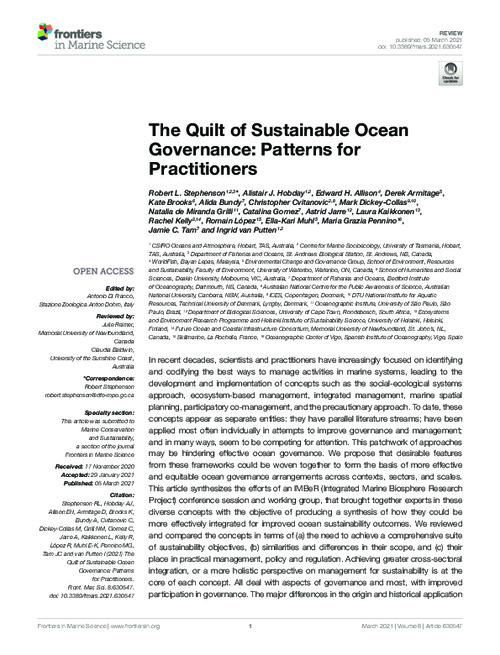The Quilt of Sustainable Ocean Governance: Patterns for Practitioners
Abstract
In recent decades, scientists and practitioners have increasingly focused on identifying and codifying the best ways to manage activities in marine systems, leading to the development and implementation of concepts such as the social-ecological systems approach, ecosystem-based management, integrated management, marine spatial planning, participatory co-management, and the precautionary approach. To date, these concepts appear as separate entities: they have parallel literature streams; have been applied most often individually in attempts to improve governance and management; and in many ways, seem to be competing for attention. This patchwork of approaches may be hindering effective ocean governance. We propose that desirable features from these frameworks could be woven together to form the basis of more effective and equitable ocean governance arrangements across contexts, sectors, and scales. This article synthesizes the efforts of an IMBeR (Integrated Marine Biosphere Research Project) conference session and working group, that brought together experts in these diverse concepts with the objective of producing a synthesis of how they could be more effectively integrated for improved ocean sustainability outcomes. We reviewed and compared the concepts in terms of (a) the need to achieve a comprehensive suite of sustainability objectives, (b) similarities and differences in their scope, and (c) their place in practical management, policy and regulation. Achieving greater cross-sectoral integration, or a more holistic perspective on management for sustainability is at the core of each concept. All deal with aspects of governance and most, with improved participation in governance. The major differences in the origin and historical application of each concept are reflected in the degree of implicit or explicit focus given to different objectives of sustainability. Overall, the concepts are especially strong for ecological and institutional or governance considerations, moderately strong for economic aspects, and weakest for the social-cultural pillar of full spectrum sustainability. There is no panacea, and no emergent hierarchy among concepts. Some concepts fit better with top-down legislation-based efforts, others with more bottom-up stakeholder driven efforts. The selection of the core concepts for a situation will depend in a large part on which concepts are specified, or demand focus, in the legal and policy context of the situation (or area) of interest. No matter how influential or dominant a single concept might be, pragmatically, different concepts will be used in different areas, and there may always be the need for a combination of concepts and objectives woven together to achieve a cohesive quilt of sustainability

